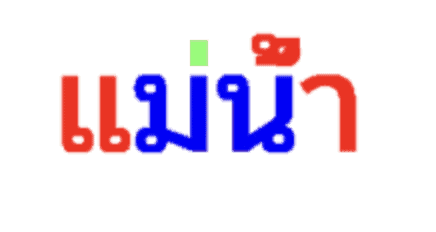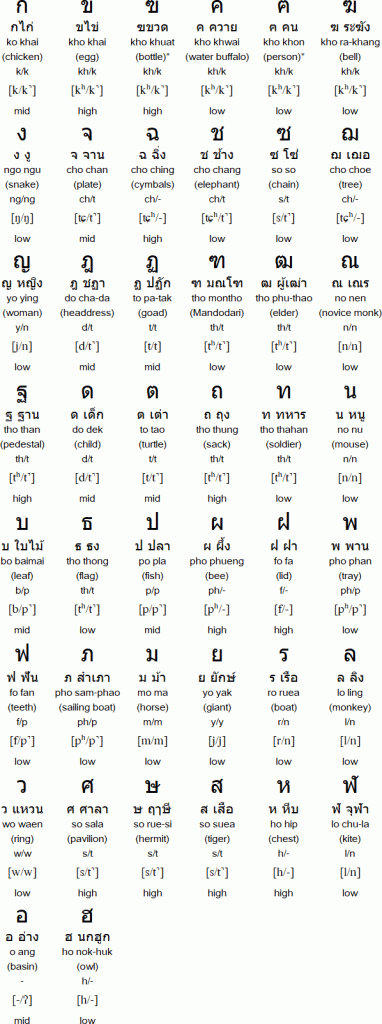Is Thai hard to learn? Some say yes, it is probably because they are not familiar with tones in languages. The Thai language is considered to be a tonal language, meaning that it is a language in which different words, with different tonal inflections, will convey different meanings. Now that already sounds hard enough, and we haven’t even touched the pronunciation or grammar of the Thai language. But learning Thai will unlock many career opportunities, and will give you better travel experiences if you’re looking to travel, work or live in Thailand.
Although the Thai language isn’t considered to be one of the easiest languages to learn for English speakers, that doesn’t mean it’s impossible. Many aspects make Thai a difficult language to learn, but if you are dedicated and you practice daily, it can also be really easy.

Is Thai hard to learn: Aspects of Thai Language
- Reading and writing: The script is quite daunting, with many vowels and consonants to learn, and if you’re not used to Abugida alphabets it can take a while to get used to.
- Dialects: There are bound to be different dialects of the Thai language in such a big country. This can make it a bit harder to learn Thai. However, the Central Thai variety is considered the most widely spoken.
- Pronunciation: Thai has 5 tones, and many sounds are not found in English. Each tone can change the meaning of a word too. This can make it quite difficult to learn for beginners.
- Thai Grammar: The grammar is subject-verb-object, the same as in English. The tenses and sentence structure is easy to grasp and learn.
- Vocabulary: The Thai language has a lot of loan words, and the compounding nature of its vocabulary, makes it easy to learn new words.
Why Is Thai Hard to Learn?
From different tones and dialects to the tricky script it uses, the Thai language can be pretty difficult to learn and master. But with dedication, patience, and daily practice you can master this difficult language, and maybe even become fluent in it. There are many online language courses to help make your Thai language learning journey a bit easier.
Reading and Writing Looks Confusing
Thai uses its own script, which can cause quite a few problems for learners. Like the Chinese, Korean and Japanese scripts, it’s best to learn the Thai script from the start, to help you get used to reading and writing it.
Thai script is believed to have come from the Khmer script, used in the Khmer language of Cambodia. The Thai script is very closely linked to the Lao script, used in the Lao language of Laos.
The alphabet is made up of 44 consonants, 18 vowels, and 6 diphthongs:
The red symbols are vowels, the blue symbols are consonants and the green symbols are tone markers.

Now check if you can spot these in the example words & phrases below:
- Mother | แม่ | Mæ̀
- Father | พ่อ | Ph̀x
- Good Morning | สวัสดีตอนเช้า | S̄wạs̄dī txn chêā
- How are you? | คุณเป็นอย่างไรบ้าง | Khuṇ pĕn xỳāngrị b̂āng
Key Features of Thai Reading/Writing:
- The script is formed with the main consonant shape, around which tones and vowels are formed.
- There are no spaces between words. Spaces occur at the end of sentences instead.
- The script is written from left to right.

Many Dialects Throughout Thailand
As with any other spoken language in the world, Thai has been influenced by other regions and neighboring countries. This has led to different dialects in the different regions of Thailand. Thai dialects are categorized according to the different parts of Thailand, these are North, North-East, South, and Central Tai.
Learning the subtle, yet noticeable differences in the different Thai dialects can be quite a difficult task, especially if you’re just beginning to learn Thai. But the Central Thai dialect is considered the most common dialect and is thus the one many people learn. So that means you don’t have to spend your time learning all the different dialects, although it could come in handy to learn a few phrases from each.
Below we’ll use the sentence “The food is very delicious” to outline the differences in the Thai dialects:
- Central Thai/Standard Thai (ภาษากลาง): The food is very delicious | อาหารอร่อยมาก | aa hăan à-ra auy mâak
- Northern Thai (ภาษาเหนือ): The food is very delicious | อาหารลำขนาด | aa hăan lam khà-nàat
- North-Eastern Thai (ภาษาอีสาน): The food is very delicious | อาหารแซบหลาย | aa hăan sàaeb lăai
- Southern Thai (ภาษาปักษ์ใต้): The food is very delicious | หรอยจังหู้ | ràauy jang hûu
Below is a video extending more in-depth on the different dialects briefly discussed above:
Thai Pronunciation Is Very Different
Because Thai is a tonal language, it means that each tone of different words can give a different meaning. This is extremely tricky to get the hang of, since the English language and many other languages don’t have different tones on the same word, giving it a different meaning. We are familiar with homophones which, when compared to the five tones of Thai, isn’t that difficult to get the hang of.
Despite the difficulty of the tones, it is recommended to listen to them being pronounced with your eyes closed. When closing your eyes, you will not see the words as all being the same with a different tone marker, but rather you’ll be hearing the subtle differences in pronunciation of each tone. If you can differentiate between the five tones in Thai your pronunciation will be flawless.
Here are the five tones you’ll have to get used to with an example word, as well as pronunciation audio:
- Middle Tone: ไม | māi – with this tone you start with a middle pitch and continue until the end
- Low Tone: ใหม่ | mài – with this tone start at a low pitch, and drop to a lower pitch
- Falling Tone: ไม่ | mâi – with this tone starts with a high pitch, go up slightly, then drop down
High Tone: ไม้ | mái – with this pitch starts with a high pitch, and raise it higher slightly as you continue
Rising Tone: ไหม | măi – with this pitch start at the low/middle pitch, then raise the pitch
Below are two videos that explain the tones and their pronunciation in greater detail:
Why Is Thai Easy to Learn?
Thai might take a while to get used to and learn, but it’s not the most difficult language in the world. The most difficult part is the five tones to learn, get used to, and train yourself to distinguish between them. The grammar is very simple to understand, and the vocabulary has many loan words from English so that’s easy! All you have to do is practice daily, and stay dedicated to learning the language.
Thai Grammar
In many other languages, grammar is the most difficult aspect to learn and master. But fortunately for you, Thai is known for its relatively easy grammar rules and sentence structures.
The grammar of any language is supported by various grammar rules, that must be followed to be able to master the language. On top of that, there are exceptions to some rules, which can make some people nervous about learning the grammar of another language. Lucky for you, Thai has very few fixed grammar rules, and the ones they do have are very easy to understand.
Here are the main grammar elements you must understand:
- Sentence Structure – Thai also uses the Subject-Verb-Object structure in their sentences
I drink coffee – Subject-Verb-Object
Sometimes when Thai people want to focus on the object they will change this structure to Object-Verb-Subject, the passive form.
Coffee drink I – Object-Verb-Subject
- Verb Conjugation – There’s no conjugation in Thai grammar. They don’t even have tenses! So all you have to do is, use the verb as is and add other words to add context.
- Pronouns – There are many more pronouns than there are in English. The options range from male/female, formal/informal and even for the age of the person, you are talking to. There are also special pronouns to use when speaking to a monk.
- Nouns – Nouns don’t change for gender, or whether they are singular or plural.
- Adjectives – The adjective comes after the noun it describes in Thai.
Vocabulary
As with any other language, you need to build your vocabulary to be able to speak the language. With each new word you learn, you open new avenues of thought, that allow you to pursue different conversational topics. Learning new words also enable you to express your thoughts and feelings.
Thai vocabulary is mostly monosyllabic, meaning that the majority of words in Thai consist of only one syllable. Words are formed by repeating the same word or compounding smaller, existing words into larger words.
- Purse | กระเป๋าตังค์ | krapao-tang – bag + money
- Honey | น้ำผึ้ง | nam-phueng – water + bee
The Thai language also has many loan words from, Chinese, French, Spanish, English, and many more languages. This makes their vocabulary a bit easier since many words are similar to those found in English and other languages. Here’s a list of some English loan words found in Thai:
- Captain | กัปตัน | kap-tan
- Dinosaur | ไดโนเสาร์ | dai-no-sao
- Plastic | พลาสติก | phlat-tik
- Visa | วีซ่า | wi-sa
What are the Reasons to Learn Thai?
Thailand is home to many amazing and breathtaking places to explore. The language is beautiful and expressive, and the culture in Thailand is ancient and inspiring. If this doesn’t convince you to learn Thai then below we have a list of reasons that are sure to convince you to learn Thai:
Make Traveling in Thailand More Enjoyable
Enchanting landscapes, fascinating culture, astonishingly beautiful beaches, and delicious food. This makes Thailand a worthy candidate when thinking about your next vacation. Being able to speak and understand the language will undoubtedly make your trip more enjoyable.

Working in Thailand Is a Valuable Experience
Thailand offers many jobs, in various fields. But to be able to work there you have to be able to speak and understand the language. If you plan to live and work in Thailand for a long time, it’s definitely advisable to learn Thai.
Learn How to Bargain in Thai Like a Pro
Sometimes shopkeepers will scam foreigners. Since they believe that foreigners aren’t aware of the fair/actual price, it’s easy to sell things at higher prices. But if you speak to them in Thai, and make them feel like you are a pro-bargainer. This will save you a lot of money.
Connecting with so Many People
Nearly 70 million people speak Thai as a native or second language. The majority of the people in Thailand, especially outside the big cities don’t speak or understand English. This will leave you feeling quite isolated if you don’t know the language. So learning Thai will connect you to so many people to talk to and befriend.

Learning Thai Doesn’t Always Have to Be Hard
Every new language you aim to learn will be difficult. That’s because it’s a language you don’t know and didn’t grow up learning. Thai is no exception, sure the tones and script can be scary, but if you’re dedicated and you practice daily, you’ll master Thai in no time.
This article has highlighted and explained the aspects that make Thai difficult, as well as the aspects that make it easy to learn. It also highlighted the reasons for learning Thai, as well as how to get started on your Thai learning journey. Here’s a list of affordable, native Thai tutors, to help you master Thai.
If you’re interested in learning any other languages, but you’re not sure what language to learn or you’re looking to learn a specific language check out AmazingTalker now.
Discover the answers to your language-related questions on AmazingTalker’s Q&A page.


















